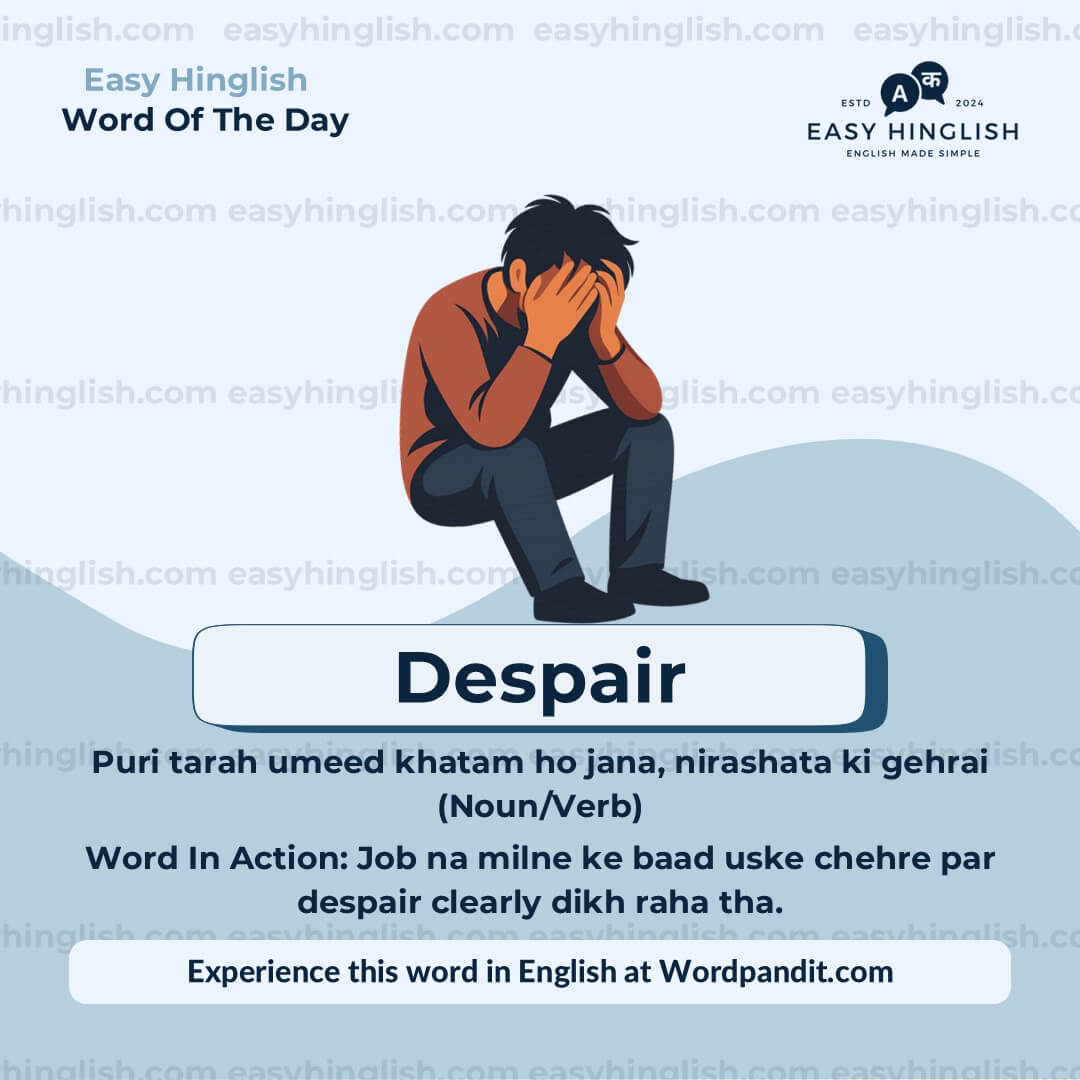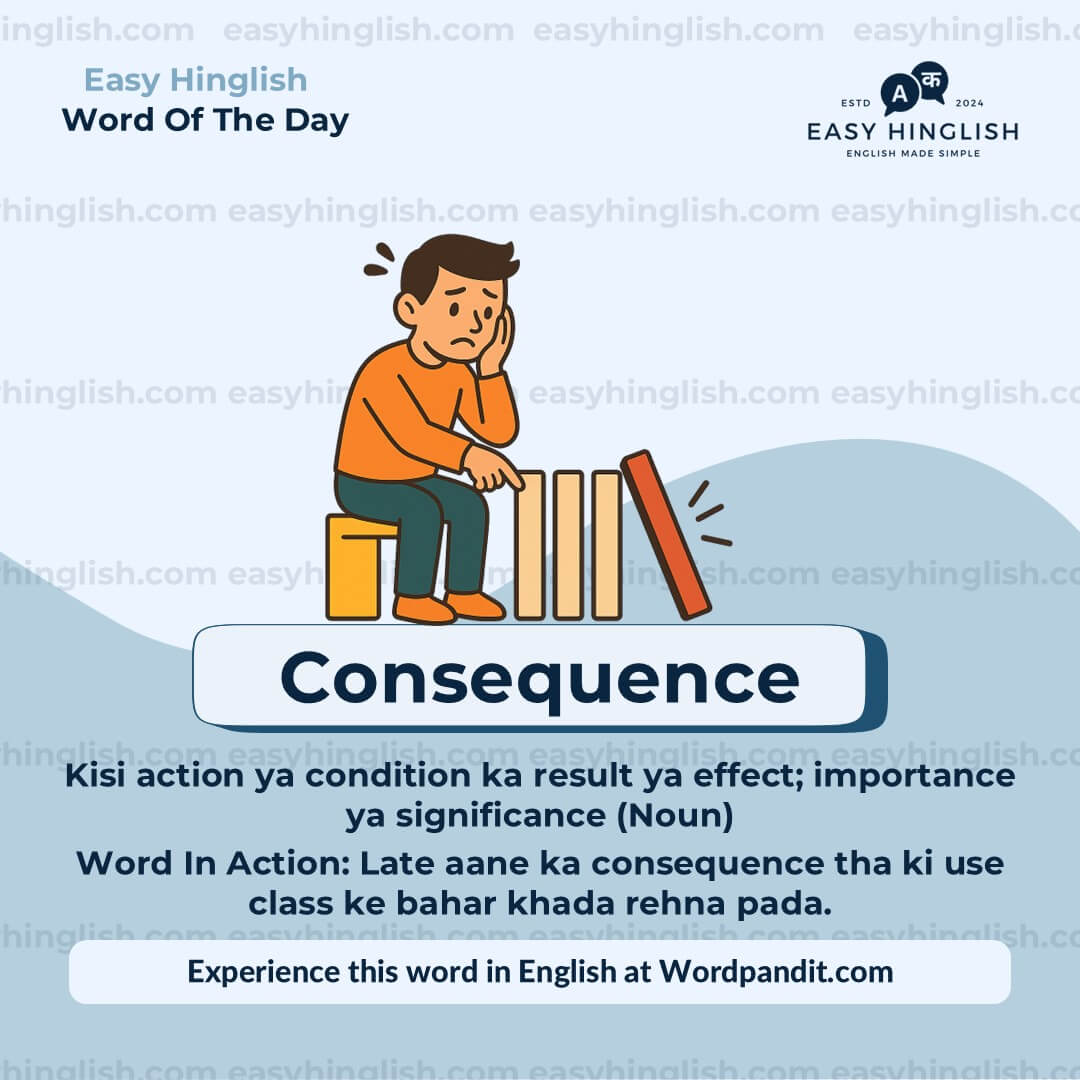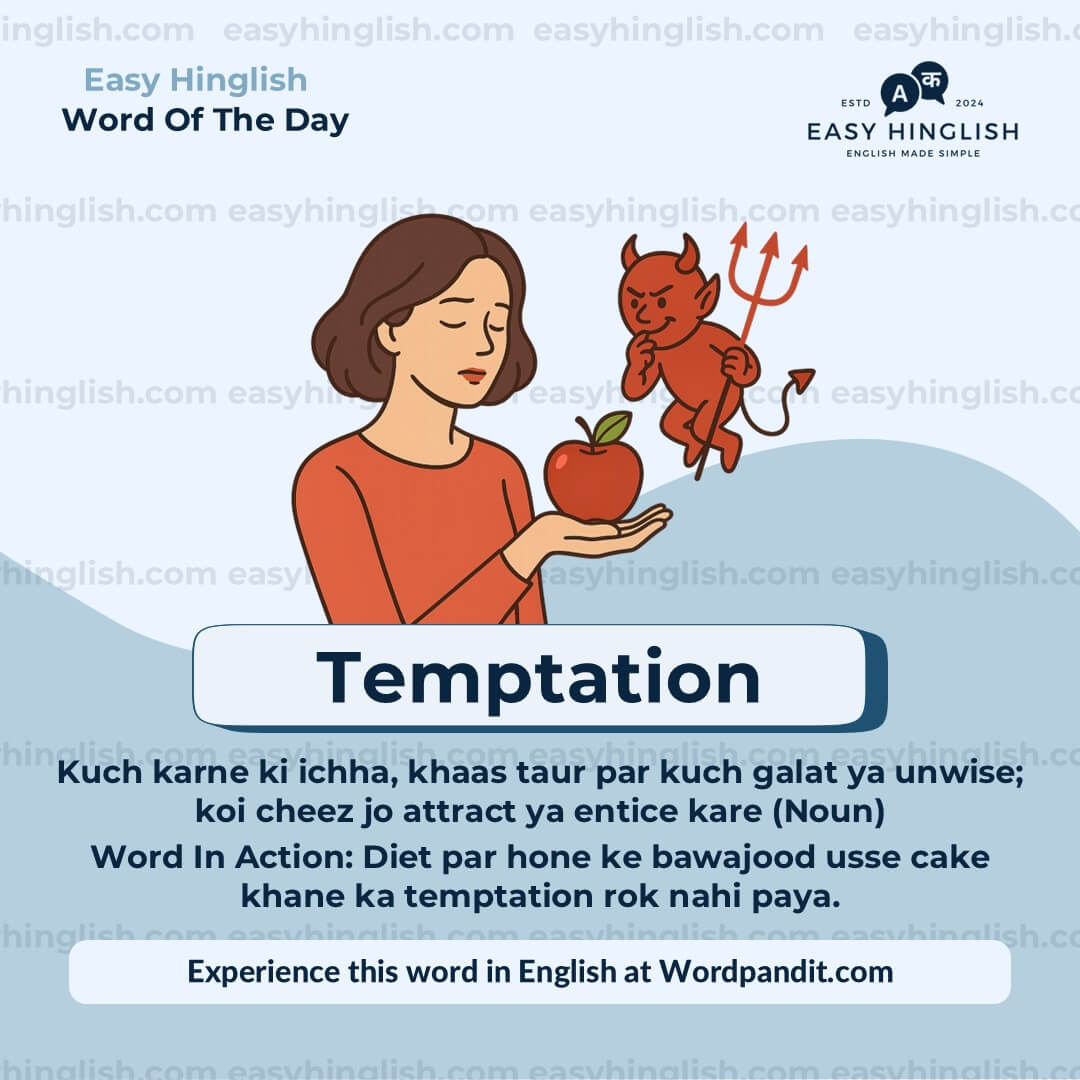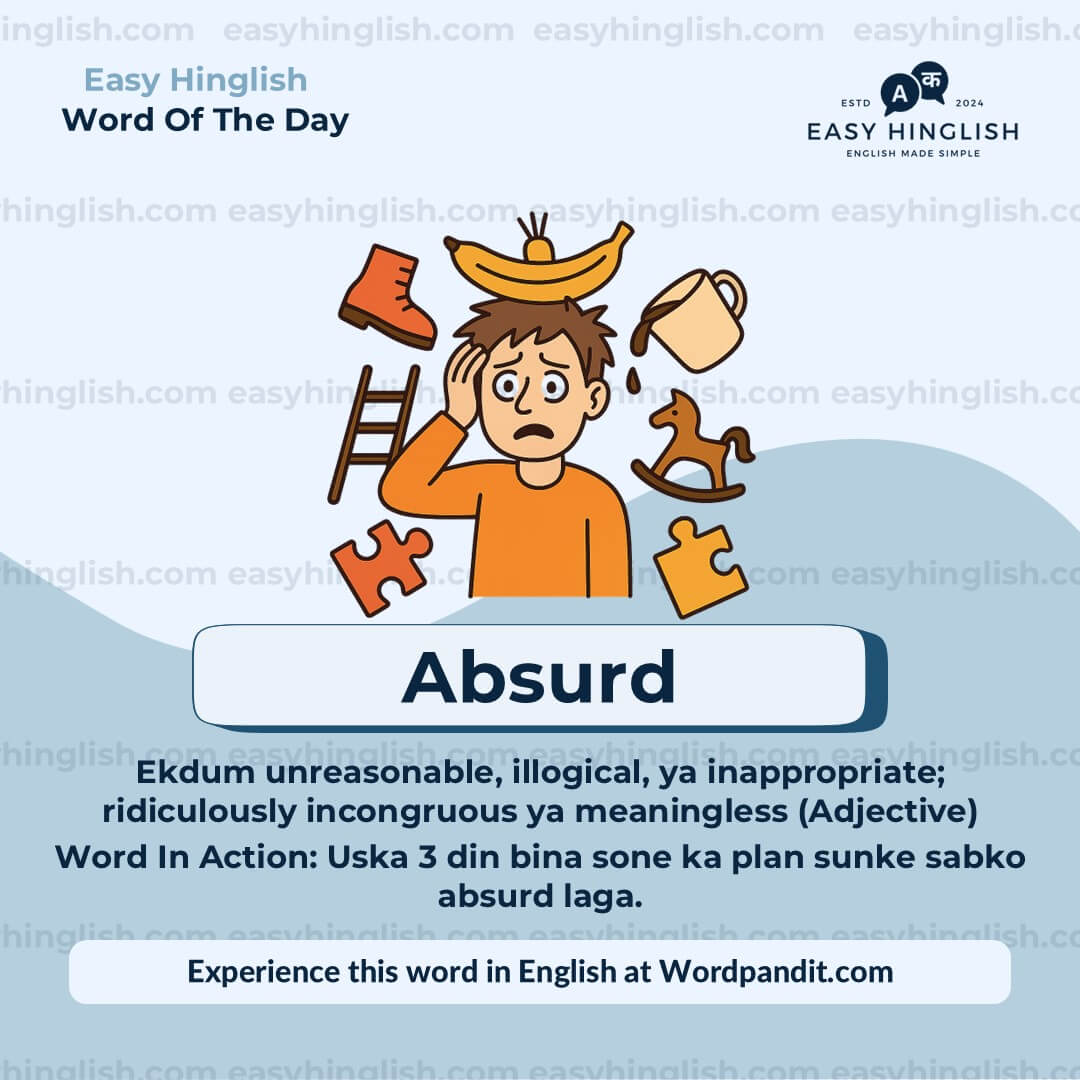Daily Vocabulary Indian Newspapers aur Publications se Seekho
Welcome to Wordpandit ka Indian Vocabulary Hub
Wordpandit par, hum samajhte hain ki ek achhi vocabulary develop karne ke liye local context samajhna bhi zaroori hai. Is section ka focus hai aapke vocabulary ko India ke leading newspapers aur publications se naye shabdon aur phrases ke zariye improve karna, taaki aap practical, relevant, aur uniquely Indian words seekh sakein.
Indian Sources Itne Important Kyun Hain?
Hum maante hain ki kisi bhi language ko sikhne ka sabse best tareeka hai uske local content me immerse hona. Isi wajah se hum carefully words curate karte hain top Indian newspapers aur publications se, jaise:
- The Hindu
- The Times of India
- The Economic Times
- Hindustan Times
- Live Mint
- The Indian Express
- Aur bhi bahut saare...
Hamesha Updated Raho, Hamesha Relevant Raho
Daily updates ke saath, aap Indian news sources se naye words seekhoge jo Indian society aur culture ke latest trends ko reflect karte hain. Hamara focus hai aise words provide karna jo aapke liye real-world me useful ho.
Wordpandit Aapke Learning Goals Ko Kaise Support Karta Hai?
Chahe aap exams ki preparation kar rahe ho, professional communication improve karna chahte ho, ya sirf naye words seekhna chahte ho, Wordpandit har step par aapki madad karega.
Practical Tareeke Se Seekho
Hamari interactive learning methodology me real-world examples, engaging activities, aur context-based usage shamil hain, taaki har naya shabd aapki active vocabulary ka hissa ban sake.
Aaj Hi Indian Vocabulary Seekhna Shuru Karo!
Wordpandit Kyun Choose Karein?
Practical Learning: Aise words seekho jo aapko real-world reading aur communication me sach me kaam aayenge, taaki aapki comprehension aur bolne ki skills improve ho.
Diverse Content: Current affairs se lekar scientific breakthroughs tak, hamare different sources aapko multiple domains ka vocabulary sikhate hain.
Effortless Integration: Wordpandit ko apni daily routine ka part banao. Sirf kuch minute har din dene se aapki vocabulary time ke saath kaafi improve ho sakti hai.
Aapka Vocabulary Mastery Tak Ka Safar
- Regularly hamare Daily Vocabulary section ko visit karo
- Naye words explore karo aur unka context me use samjho
- In words ko apni writing aur bolne ki practice me use karne ki koshish karo
- Jaise-jaise aapke words badhte hain, apni progress ko track karo
Aaj Se Apni Vocabulary Journey Shuru Karo!
Wordpandit ke saath vocabulary improve karna start karo. Roz thoda effort dalne se aap ek strong vocabulary develop kar sakte ho jo academic, professional, aur personal life me kaafi kaam aayegi.
Yaad rakho, ek naya shabd roz seekhna linguistic limitations ko door karne ka best tareeka hai! Wordpandit ko apni daily learning journey ka sathi banao aur vocabulary excellence ki taraf badho!
WORD-1: Despair
Sandarbh (Context):
"...often a consequence of depression and despair..." — complete loss of hope. - Article by Tapan Susheel
Vyakhya (Explanatory Paragraph):
Despair ka matlab hai puri tarah se umeed khatam ho jana, jab lagta hai ki ab kuch bhi theek nahi hoga. Yeh word tab use hota hai jab koi insaan bilkul nirash ho jaye aur future ko lekar koi positive expectation na rahe—sirf sadness se zyada, complete hopelessness. Despair ko formal writing, literature, psychological discussions aur competitive exam passages mein use karte hain jahan extreme emotional states ko describe karna ho, jahan optimism ki ek bhi kiran nahi bachti.
Arth (Meaning): Puri tarah umeed khatam ho jana, nirashata ki gehrai (Noun/Verb)
Uccharan (Pronunciation): dih-SPAIR / डिस्पेअर
Kathinai Star (Difficulty Level): ⭐⭐ Basic se Intermediate
Utpatti (Etymology): Despair Latin word 'desperare' se aaya hai jiska matlab hai 'sari umeed kho dena,' jo 'de-' (without) aur 'sperare' (hope) se bana hai. Yeh word Old French 'desperer' ke through 14th century mein English mein aaya. Shuruat se lekar aaj tak, despair ka meaning consistent raha hai—complete hopelessness, jahan improvement ki possibility bhi impossible lagti hai. Yeh emotional states ka sabse dark form represent karta hai.
Prashant Sir Ke Tathya (Prashant Sir's Notes):
Bahut students 'despair' ko 'disappointment' ya 'sadness' se confuse karte hain, lekin despair aur disappointment mein kya farak hai yeh CAT aur GRE ke liye bahut important hai. Disappointment temporary dissatisfaction hai, jabki despair complete, overwhelming hopelessness dikhata hai. UPSC ke students ke liye, despair aksar social issues, mental health aur human suffering ke passages mein milta hai. Indian newspapers mein aapko "driven to despair" ya "depths of despair" phrases aksar tab milenge jab farmers' distress, unemployment, ya social challenges discuss ho rahe hon. Despair ka sahi istemal kaise karein: yeh word intensity convey karta hai—jab sirf 'sad' ya 'disappointed' kaafi nahi hai, tab despair use karo. Competitive exam RC passages mein despair signal karta hai ki character ya situation extreme emotional low point par hai.
Samanarthi & Vipritarthi (Synonyms & Antonyms):
Samanarthi (Synonyms): hopelessness, desperation, anguish, despondency, dejection, melancholy, misery, gloom, desolation, discouragement, nirashata, mayusi
Vipritarthi (Antonyms): hope, optimism, confidence, encouragement, cheerfulness, faith, umeed, aasha
Udaharan (Usage Examples):
- Mahino tak naukri ke rejections ke baad, Priya despair mein gir gayi, soch rahi thi ki kya use kabhi apne field mein meaningful kaam milega.
- Kisaan ne sukhe se prabhavit apni fields ko despair ke saath dekha, sochte hue ki is saal apne parivaar ko kaise khilayega.
- UPSC exam mein baar baar fail hone par Rajesh despair ki karib pahunch gaya, halanki uska parivaar use encourage karta raha.
- Ek setback se despair mat karo—yaad rakho ki Sachin Tendulkar bhi difficult start ke baad hi cricket legend bane the.
Sanskritik Sandarbh (Cultural Reference):
"Despair ke pal mein, insaan ki aatma ya toot jati hai ya fir anokhi takat dhundh leti hai." - Yeh theme kayi Bollywood films jaise Taare Zameen Par aur Dangal mein explore kiya gaya hai, jahan characters seemingly hopeless situations ko overcome karte hain.
Sochiye (Think About It):
Kuch log despair se zyada strong hokar kyun nikalte hain jabki dusre usme phanse rah jate hain? Community support ka kya role hota hai kisi ko despair se hope ki taraf le jane mein?
Chhoti Kriya (Quick Activity):
Do sentences likhein jahan kisi ko despair feel ho sakta hai—ek personal challenge ke baare mein aur ek social issue ke baare mein. Notice karein ki yeh word sirf disappointment nahi, balki complete hopelessness ko kaise capture karta hai.
Yaad Karne Ka Tarika (Memory Tip):
'Despair' ko aise yaad rakhein: 'DIS-PAIR' samjho—jaise tum apne pair (hope) se dis-connected ho gaye. Jab hope tumhara pair hai aur tum usse alag ho, toh tum despair mein ho. Ya phir yaad rakho: 'De-spare' matlab tumhare paas koi spare hope nahi bacha—sab khatam ho gaya hai.
Vastavik Jeevan Me Upyog (Real-World Application):
Despair commonly mental health discussions, social commentary, literary analysis aur news reporting about human suffering mein use hota hai. CAT aur GRE reading comprehension passages mein 'despair' ko recognize karna emotional tone aur author ke message ki intensity identify karne mein madad karta hai. Journalists iska use economic hardship, natural disasters, ya personal tragedies ke stories cover karte waqt karte hain, human suffering ki gehrai convey karne ke liye. Competitive exams mein despair CAT ke liye samajhna zaroori hai kyunki yeh negative emotions ke levels ko distinguish karne mein madad karta hai—mild disappointment se lekar complete hopelessness tak.
WORD-2: Consequence
Sandarbh (Context):
"Suicide, often a consequence of depression and despair..." — result or effect of an action. - Article by Tapan Susheel
Vyakhya (Explanatory Paragraph):
Consequence ka matlab hai 'kisi action ya condition ka result ya effect'—jo kuch bhi kisi cheez ke karan hota hai. Yeh word tab use hota hai jab outcomes describe karne hon jo kisi aur cheez ke wajah se hue hon, chahe positive hon ya negative. Consequence ka sahi istemal kaise karein: cause-and-effect relationships ko samajhna zaroori hai—har action ke consequences hote hain. Yeh word formal writing, academic discussions, legal contexts aur competitive exam passages jaise CAT aur GRE mein commonly use hota hai, actions aur unke outcomes ke beech ka relationship dikhane ke liye.
Arth (Meaning): Kisi action ya condition ka result ya effect; importance ya significance (Noun)
Uccharan (Pronunciation): KON-sih-kwens / कॉन्सिक्वेन्स
Kathinai Star (Difficulty Level): ⭐⭐ Basic se Intermediate
Utpatti (Etymology): Consequence Latin word 'consequentia' se aaya hai, jo 'consequi' se bana hai jiska matlab hai 'closely follow karna,' aur yeh 'con-' (together/saath) aur 'sequi' (to follow/peechha karna) se mila hai. Yeh word 14th century mein Old French ke through English mein aaya. Shuruat mein consequence ka simple matlab tha 'jo follow kare,' lekin samay ke saath iska modern meaning develop hua—ek result ya outcome jo logically kisi previous action ya event se flow karta hai, aur cause-and-effect relationships ko emphasize karta hai.
Prashant Sir Ke Tathya (Prashant Sir's Notes):
Students aksar puchte hain: consequence aur result mein kya farak hai? Dono outcomes refer karte hain, lekin consequence formal writing mein specifically causal relationship ko emphasize karta hai aur aksar weight ya importance carry karta hai. CAT aur GRE aspirants ke liye, consequence frequently critical reasoning questions mein aata hai jahan aapko cause-effect relationships identify karni hoti hain. Consequence aur outcome mein difference subtle hai—consequence typically direct causal link suggest karta hai aur kabhi-kabhi negative effects imply karta hai, jabki outcome zyada neutral hota hai. Indian newspapers mein aapko "face the consequences" ya "as a consequence of" phrases aksar milenge jab policy decisions, climate change impacts, ya social issues discuss ho rahe hon. Consequence ka correct use: yaad rakhein ki iska matlab dono ho sakta hai—'result' aur 'importance' (jaise "a person of consequence" matlab important vyakti), lekin competitive exams mein pehla meaning zyada common hai.
Samanarthi & Vipritarthi (Synonyms & Antonyms):
Samanarthi (Synonyms): result, outcome, effect, aftermath, repercussion, ramification, upshot, product, corollary, implication, parinaam, natija, asar
Vipritarthi (Antonyms): cause, origin, source, beginning, antecedent, reason, karan, mool, shuruat
Udaharan (Usage Examples):
- Mumbai mein aai baadh poor urban planning aur city bhar mein inadequate drainage systems ka direct consequence tha.
- Arun ne salon tak apni health ignore ki, aur consequence yeh hua ki use serious diagnosis mila jo usne completely lifestyle change karne par majboor kar diya.
- Naye GST regulations ke consequence ke roop mein, kai chhoti businesses ko apne accounting processes restructure karne pade aur additional staff hire karna pada.
- Sneha ne coaching classes skip karne ka decision liya aur uske predictable consequences the—CAT examination ke dauran use complex problems solve karne mein struggle karna pada.
Sanskritik Sandarbh (Cultural Reference):
"Har action ke consequences hote hain—karma hamesha wapas aata hai." - Yeh siddhant Indian philosophy mein gehre se rooted hai aur Bollywood films jaise OMG aur PK mein frequently reference kiya gaya hai, jahan characters apne choices ke consequences face karte hain.
Sochiye (Think About It):
Log aksar apne actions ke long-term consequences ko consider kyun nahi karte? Consequences ko samajhna humein apni personal aur professional life mein behtar decisions lene mein kaise madad kar sakta hai?
Chhoti Kriya (Quick Activity):
Teen sentences likhein jismein 'consequence' use karke daily life mein observe hone wale cause-and-effect relationships describe karein—shayad environmental issues, social media usage, ya academic choices se related. Notice karein ki yeh word actions ko unke results se kaise connect karta hai.
Yaad Karne Ka Tarika (Memory Tip):
'Consequence' ko 'CON-SEQUENCE' mein todein—isko aise samjhein ki ek SEQUENCE jo saath aata hai (CON ka matlab 'with' ya 'together'). Har action ek sequence of events start karta hai, aur consequence wahi hai jo us sequence mein aata hai. Ya phir Hindi phrase "परिणाम भुगतना" (parinaam bhugatna) yaad rakhein—consequences face karna.
Vastavik Jeevan Me Upyog (Real-World Application):
Consequence extensively legal documents, policy papers, academic research, business analysis aur ethical discussions mein use hota hai. CAT reading comprehension aur GRE verbal reasoning mein consequence ko recognize karna events aur outcomes ke beech logical relationships identify karne mein madad karta hai. Journalists iska use policy decisions, climate change effects, ya economic impacts analyze karte waqt karte hain. Formal business communication mein, consequence ka sahi use risk assessment, strategic planning aur decision-making processes discuss karte waqt essential hai. UPSC aspirants ke liye yeh word frequently essay writing aur ethics papers mein milta hai jahan cause-effect analysis crucial hota hai.
WORD-3: Pathological
Sandarbh (Context):
"...diagnosed and treated objectively based on pathological findings..." — related to disease or abnormal conditions. - Article by Tapan Susheel
Vyakhya (Explanatory Paragraph):
Pathological ka matlab hai 'bimari se related ya bimari ke karan hona; iska use compulsive ya extreme behavior describe karne ke liye bhi hota hai.' Yeh word medical conditions ke liye use hota hai jahan disease processes involved hon, ya metaphorically kisi behavior ko describe karne ke liye jo abnormal ya unhealthy ho. Pathological ka sahi istemal context par depend karta hai—medicine mein yeh disease-related findings describe karta hai, jabki everyday language mein extreme, compulsive behaviors ke liye use hota hai. Pathological commonly medical literature, psychological discussions, formal writing aur competitive exam passages mein use hota hai abnormality ya disease indicate karne ke liye.
Arth (Meaning): Bimari se related ya bimari ke karan; compulsive ya obsessive behavior jo extreme degree tak ho (Adjective)
Uccharan (Pronunciation): path-uh-LOJ-ih-kuhl / पैथोलॉजिकल
Kathinai Star (Difficulty Level): ⭐⭐⭐ Intermediate
Utpatti (Etymology): Pathological Greek word 'pathologia' se aaya hai, jo 'pathos' (suffering, disease/dukh, bimari) aur 'logia' (study of/adhyayan) se bana hai. Yeh word 17th century mein medical English mein aaya jab diseases ki science develop hui. Shuruat mein strictly medical contexts mein use hota tha disease processes aur abnormal tissue changes describe karne ke liye, lekin gradually pathological ka metaphorical usage bhi badha, aur kisi bhi extreme, compulsive ya unhealthy behavior ya condition ko describe karne laga—'disease' ka concept physical se behavioral abnormalities tak extend ho gaya.
Prashant Sir Ke Tathya (Prashant Sir's Notes):
Bahut students pathological ko 'psychological' se confuse karte hain, lekin pathological aur psychological mein difference competitive exams ke liye important hai. Psychological mind aur mental processes se related hai, jabki pathological specifically disease ya abnormal conditions indicate karta hai—chahe physical hon ya behavioral. CAT aur GRE aspirants ke liye, pathological dono scientific passages aur social commentary mein aata hai. Pathological aur pathetic mein kya farak hai? Yeh common confusion similar sounds ke karan hoti hai—pathetic ka matlab hai 'pity evoke karna' ya 'inadequate,' jabki pathological ka matlab hai 'disease-related' ya 'compulsive.' Indian newspapers mein aap 'pathological liar' (jo compulsively jhooth bolta hai) ya medical reports mein 'pathological findings' dekhenge. UPSC essays ke liye pathological ka use: yeh perfect hai jab social issues discuss karne hon jaise 'pathological corruption' ya society mein 'pathological behavior patterns.'
Samanarthi & Vipritarthi (Synonyms & Antonyms):
Samanarthi (Synonyms): morbid, diseased, unhealthy, abnormal, compulsive, obsessive, extreme, irrational (behavioral context), clinical (medical context), rog-sambandhi, asaamaanya
Vipritarthi (Antonyms): healthy, normal, natural, balanced, rational, moderate, wholesome, swasth, saamaanya, santulit
Udaharan (Usage Examples):
- Tissue samples ki pathological examination ne cancerous cells reveal kiye, jisse AIIMS ke doctors ne patient ke liye turant treatment recommend kiya.
- Ramesh apne colleagues ke prati pathological jealousy dikhata tha, constantly conspiracies suspect karta tha tab bhi jab sab genuinely uski help karne ki koshish karte the.
- Forensic pathologist ki report ne crucial pathological evidence provide kiya jo Mumbai police ko mysterious death case ek hafta mein solve karne mein madad ki.
- Priya ki perfection ki pathological need ne use har email paanch baar rewrite karne par majboor kiya, simple tasks ko exhausting ordeals mein badal diya jo uski productivity ko affect karne lage.
Sanskritik Sandarbh (Cultural Reference):
"Villain ka revenge ke prati pathological obsession ne puri plot ko drive kiya." - Yeh common theme psychological thrillers jaise Kahaani aur Andhadhun mein hota hai, jahan characters extreme, compulsive behaviors display karte hain jo unki defining traits ban jati hain.
Sochiye (Think About It):
Kisi strong habit ya preference ko pathological behavior kis point par mana jata hai? Apne achievement-driven society mein hum passion aur pathological obsession ke beech ka farak kaise distinguish kar sakte hain?
Chhoti Kriya (Quick Activity):
Do sentences likhein jismein 'pathological' use karein—ek medical context mein (jaise test results ya disease) aur ek extreme behavior describe karte hue (jaise lying, jealousy, ya perfectionism). Notice karein ki yeh word literal aur metaphorical dono tarah se kaise kaam karta hai.
Yaad Karne Ka Tarika (Memory Tip):
'Pathological' ko 'PATH-OLOGY' ke through yaad rakhein—PATH (suffering/disease/dukh/bimari) ka adhyayan. Path lab (pathology laboratory) ke baare mein sochein jahan doctors bimarion ka adhyayan karte hain. Ya ise 'pathos' (suffering/dukh) se connect karein—pathological ka matlab hai suffering ya disease se related. Cricket terms mein, "pathological collapse" sochein—jab team ki batting failure itni extreme aur compulsive ho ki ek bimari jaise lage!
Vastavik Jeevan Me Upyog (Real-World Application):
Pathological extensively medical reports, forensic investigations, psychological assessments aur academic research papers mein use hota hai. CAT aur GRE reading comprehension mein, pathological competitive exams ke liye science passages mein disease mechanisms discuss karte waqt aur social commentary mein extreme behaviors describe karte waqt aata hai. Healthcare professionals iska use diagnostic findings discuss karte waqt karte hain—'pathological changes in tissue' ya 'pathological test results.' Journalism aur opinion pieces mein, writers pathological ko metaphorically societal issues describe karne ke liye use karte hain jaise 'pathological corruption' ya 'pathological lying in politics,' jo ise UPSC essay writing aur current affairs discussions ke liye essential vocabulary banata hai.
WORD-4: Temptation
Sandarbh (Context):
"Camus argues that suicide is a natural temptation for humans." — desire to do something wrong or unwise. - Article by Tapan Susheel
Vyakhya (Explanatory Paragraph):
Temptation ka matlab hai 'kuch karne ki tez ichha ya urge, khaas taur par kuch galat, foolish ya pleasurable karne ki.' Yeh word tab use hota hai jab inner conflict describe karna ho—jo hum karna chahte hain aur jo humein karna chahiye, uske beech ka. Temptation ka sahi istemal karne ke liye yeh samajhna zaroori hai ki yeh kisi aisi cheez ki taraf attraction represent karta hai jo beneficial ya appropriate nahi ho sakti. Temptation commonly moral discussions, psychological contexts, religious writings aur competitive exam passages mein use hota hai human nature, self-control aur decision-making challenges explore karne ke liye.
Arth (Meaning): Kuch karne ki ichha, khaas taur par kuch galat ya unwise; koi cheez jo attract ya entice kare (Noun)
Uccharan (Pronunciation): temp-TAY-shuhn / टेम्पटेशन
Kathinai Star (Difficulty Level): ⭐⭐ Basic se Intermediate
Utpatti (Etymology): Temptation Latin word 'temptationem' se aaya hai, jo 'temptare' se derived hai jiska matlab hai 'to test, try, ya entice karna.' Yeh word 13th century mein Old French 'temptacion' ke through English mein aaya, originally religious contexts mein use hota tha spiritual trials aur enticements describe karne ke liye. Centuries ke dauran, temptation primarily religious usage (devil's temptations) se broader psychological aur everyday meanings tak evolve hua, encompass karte hue koi bhi strong urge kuch aisa karne ki jo hum jaante hain harmful, unwise, ya simply indulgent ho sakta hai—dessert khane se lekar impulsive purchases tak.
Prashant Sir Ke Tathya (Prashant Sir's Notes):
Students aksar puchte hain: temptation aur desire mein kya farak hai? Dono mein kuch chahne ka involvement hai, lekin temptation specifically imply karta hai ki desired cheez galat hai, unwise hai, ya negative consequences ke saath aati hai. Desire neutral hai, lekin temptation moral ya practical conflict carry karta hai. CAT aur GRE reading comprehension ke liye, temptation frequently ethics, psychology aur human behavior ke passages mein aata hai—especially jab authors self-control aur decision-making discuss karte hain. Temptation aur attraction mein difference yeh hai ki temptation mein yeh jaanna involved hai ki kuch potentially harmful hai phir bhi uspe drawn feel karna. Indian newspapers mein aapko "resist the temptation" ya "succumb to temptation" phrases milenge jab corruption, consumer behavior, ya policy decisions discuss ho rahe hon. UPSC ethics papers ke liye temptation ka use: yeh perfect hai jab moral dilemmas analyze karne hon jahan individuals duty aur desire ke beech conflict face karte hain.
Samanarthi & Vipritarthi (Synonyms & Antonyms):
Samanarthi (Synonyms): enticement, allurement, attraction, lure, seduction, pull, urge, desire, craving, appeal, draw, pralobhan, lalach, akarshan
Vipritarthi (Antonyms): deterrent, discouragement, repulsion, aversion, disinterest, indifference, nirodh, hatotasah
Udaharan (Usage Examples):
- Study hours ke dauran social media check karne ke temptation ke bawajud, Kavya ne apna phone lock karke rakha taaki CAT preparation par focus kar sake.
- Rishwat accept karne ka temptation strong tha, lekin honest IAS officer Sharma ne apni oath yaad ki aur incident ko turant report kar diya.
- Rohit ne latest smartphone kharidne ke temptation ko resist kiya, realize karte hue ki use apni behen ki education ke liye paise save karne chahiye.
- Competitive exams ki taiyari kar rahe students ke liye, Netflix ek constant temptation offer karta hai jo disciplined preparation ke mahino ko kuch hi dino mein derail kar sakta hai.
Sanskritik Sandarbh (Cultural Reference):
"Lead us not into temptation" Lord's Prayer ki sabse recognized lines mein se ek hai, reflecting karte hue universal human struggle against temptation—yeh theme countless Bollywood films jaise Deewar aur Sarkar mein explore kiya gaya hai, jahan characters moral temptations face karte hain jo unke principles test karte hain.
Sochiye (Think About It):
Hum aksar un cheezon ke liye strongest temptation kyun feel karte hain jo hum jaante hain harmful hain? Kya temptation ko resist karna humein stronger banata hai, ya constant temptation eventually strongest willpower ko bhi wear down kar deta hai?
Chhoti Kriya (Quick Activity):
Teen sentences likhein un temptations ke baare mein jo aap daily life mein face karte hain—shayad food, social media, procrastination, ya paise kharch karne se related. Reflect karein ki kaun se temptations resist karna sabse mushkil hain aur kyun.
Yaad Karne Ka Tarika (Memory Tip):
'Temptation' ko 'TEMP-TATION' ke roop mein sochein—imagine karein ki kuch temporarily aapko ek station (destination) ki taraf attract kar raha hai jahan aapko jaana nahi chahiye. Ya phir Hindi word 'प्रलोभन' (pralobhan) se connect karein. Famous devil-and-angel-on-shoulders image yaad rakhein—devil temptation represent karta hai, whispering "do it!" jabki angel kehta hai "don't!" Yahi conflict hai jo temptation create karta hai.
Vastavik Jeevan Me Upyog (Real-World Application):
Temptation widely psychology, marketing, behavioral economics, ethics discussions aur self-help literature mein use hota hai. CAT aur GRE reading comprehension passages mein, temptation competitive exams ke liye human decision-making, moral philosophy aur behavioral patterns explore karne wale contexts mein aata hai. Marketers deliberately advertisements aur sales strategies ke through temptation create karte hain. UPSC ethics papers mein, temptation ko samajhna crucial hai jab corruption, conflicts of interest aur moral dilemmas ke case studies analyze karne hon. Journalists iska use policy failures, consumer behavior, ya political scandals discuss karte waqt karte hain—jo ise current affairs analysis aur human nature aur societal challenges ke baare mein essay writing ke liye essential vocabulary banata hai.
WORD-5: Absurd
Sandarbh (Context):
"...which he broadly discussed in the framework of absurd." — illogical, meaningless, or ridiculous. - Article by Tapan Susheel
Vyakhya (Explanatory Paragraph):
Absurd ka matlab hai 'poori tarah se unreasonable, illogical, ya inappropriate; ridiculously incongruous ya meaningless.' Yeh word tab use hota hai jab kuch aisa describe karna ho jo logic ya reason ko itna defy karta hai ki laughable ya incomprehensible lag jaye. Absurd ka sahi istemal tab karte hain jab situations, ideas, ya actions itne unreasonable hon ki almost comical lagein. Absurd commonly philosophical discussions, literary criticism, everyday conversations aur competitive exam passages mein use hota hai irrationality, meaninglessness, ya human existence aur social situations ki ridiculous nature highlight karne ke liye.
Arth (Meaning): Ekdum unreasonable, illogical, ya inappropriate; ridiculously incongruous ya meaningless (Adjective)
Uccharan (Pronunciation): ab-SURD ya ab-ZURD / ऐब्सर्ड
Kathinai Star (Difficulty Level): ⭐⭐ Basic se Intermediate
Utpatti (Etymology): Absurd Latin word 'absurdus' se aaya hai jiska matlab hai 'out of tune, discordant,' jo 'ab-' (away from/door se) aur 'surdus' (deaf, dull/bahra, dheema) se bana hai. Yeh word originally musical discord describe karta tha—awaazein jo harmony ke liye "deaf" thin. Yeh 16th century mein French 'absurde' ke through English mein aaya. Samay ke saath, absurd literal discord describe karne se metaphorical disharmony with reason aur logic tak evolve hua. 20th century ke existentialist philosophers, khaas taur par Albert Camus, ne 'the absurd' ko ek philosophical concept tak elevate kiya jo human existence ki fundamental meaninglessness aur irrationality describe karta hai.
Prashant Sir Ke Tathya (Prashant Sir's Notes):
Bahut students absurd ko 'ridiculous' ya 'stupid' se confuse karte hain, lekin absurd aur ridiculous ke beech ka difference CAT RC passages ke liye helpful hai. Dono unreasonable mean karte hain, lekin absurd specifically logical impossibility ya deep incongruity ko emphasize karta hai—kuch aisa jo reason ko hi violate kare. Ridiculous simply mockery deserve karne wala hota hai. GRE aur UPSC aspirants ke liye, absurd frequently philosophical contexts mein aata hai, especially jab existentialism aur 'Theatre of the Absurd' discuss ho. Absurd aur irrational mein kya farak hai? Irrational means lacking reason, jabki absurd kuch itna unreasonable suggest karta hai ki almost comical ya meaningless ho. Indian newspapers mein aapko "absurd bureaucratic rules" ya "absurd price hikes" phrases milenge jab writers sirf wrongness nahi balki logical impossibility emphasize karna chahte hain. Competitive exams ke liye absurd ka use: Camus ya Kafka ke baare mein RC passages mein, 'the absurd' ek technical philosophical term hai jo humans aur meaningless universe ke beech ke conflict ko describe karta hai jahan humans meaning dhoondhte hain.
Samanarthi & Vipritarthi (Synonyms & Antonyms):
Samanarthi (Synonyms): ridiculous, ludicrous, preposterous, illogical, irrational, nonsensical, foolish, unreasonable, laughable, farcical, bizarre, betuka, nirarthak, haasynajanak
Vipritarthi (Antonyms): logical, reasonable, sensible, rational, sound, practical, meaningful, coherent, tarkik, sahi, saarthak
Udaharan (Usage Examples):
- Yeh absurd lagta hai ki instant communication ke yug mein, government offices abhi bhi citizens se physical documents triplicate mein submit karne ki demand karte hain.
- Ramesh ko absurd laga ki uski company employees se overtime work ki expectation rakhti hai bina compensation ke, jabki official emails mein work-life balance preach karti hai.
- Puri examination system absurd ban gayi jab students ne discover kiya ki competitive exams crack karne ke liye concepts samajhne se zyada answers memorize karna matter karta hai.
- Priya ke parents ko uska stand-up comedian banne ka dream absurd laga, jab tak usne national comedy competition nahi jeeti aur contract sign nahi kar liya.
Sanskritik Sandarbh (Cultural Reference):
"Life is a tragedy when seen in close-up, but a comedy in long-shot." - Charlie Chaplin ki yeh observation absurd ke essence ko capture karti hai, ek concept jo brilliantly PK aur 3 Idiots jaise films mein portrayed hai, jahan societal norms aur rigid systems ko humor aur questioning ke through fundamentally absurd ke roop mein expose kiya gaya hai.
Sochiye (Think About It):
Hamare education system, bureaucracy, ya social customs ke kaun se aspects aapko absurd lagte hain jab aap sach mein unke baare mein sochte hain? Absurd practices aksar persist kyun karti hain tab bhi jab sabko unki irrationality ka ehsaas ho?
Chhoti Kriya (Quick Activity):
Apni daily life, news, ya campus se teen situations list karein jo aapko absurd strike karti hain. Har ek ke liye ek sentence likhein, explain karte hue ki situation logic ya reason ko kaise defy karti hai. Notice karein ki absurdity aksar systems aur society ke baare mein deeper truths reveal karti hai.
Yaad Karne Ka Tarika (Memory Tip):
'Absurd' ko 'AB-SURD' mein todein—sochein ki kuch AB-solutely SURD hai (reason ke liye deaf, jaise original Latin mein). Ya phonetically yaad rakhein: AB-SURD "a bird" (ek chidiya) jaisa lagta hai jo humans ke saath reason karne ki koshish kar rahi ho—completely illogical aur ridiculous! Hindi mein, ise 'बेतुका' (betuka) ya 'निरर्थक' (nirarthak) se connect karein, dono ka matlab meaningless ya illogical hai.
Vastavik Jeevan Me Upyog (Real-World Application):
Absurd extensively philosophical discussions, literary criticism, social commentary, satire aur unreasonable situations ke baare mein everyday conversations mein use hota hai. CAT aur GRE reading comprehension mein, absurd competitive exams ke liye existentialism ke baare mein passages mein aata hai, particularly Albert Camus aur 'Theatre of the Absurd' playwrights jaise Samuel Beckett ko discuss karte waqt. Journalists iska use illogical policies, bureaucratic inefficiencies, ya societal contradictions critique karte waqt karte hain—"absurd regulations" ya "absurd discrepancies." UPSC aspirants ke liye, absurd ko samajhna ethics papers ke liye crucial hai jab moral paradoxes discuss ho rahe hon aur societal issues ke baare mein essay writing ke liye. Business communication mein, professionals iska use proposals ya decisions highlight karne ke liye karte hain jo basic logic defy karte hon, jo ise critical thinking aur persuasive arguments ke liye valuable vocabulary banata hai.













